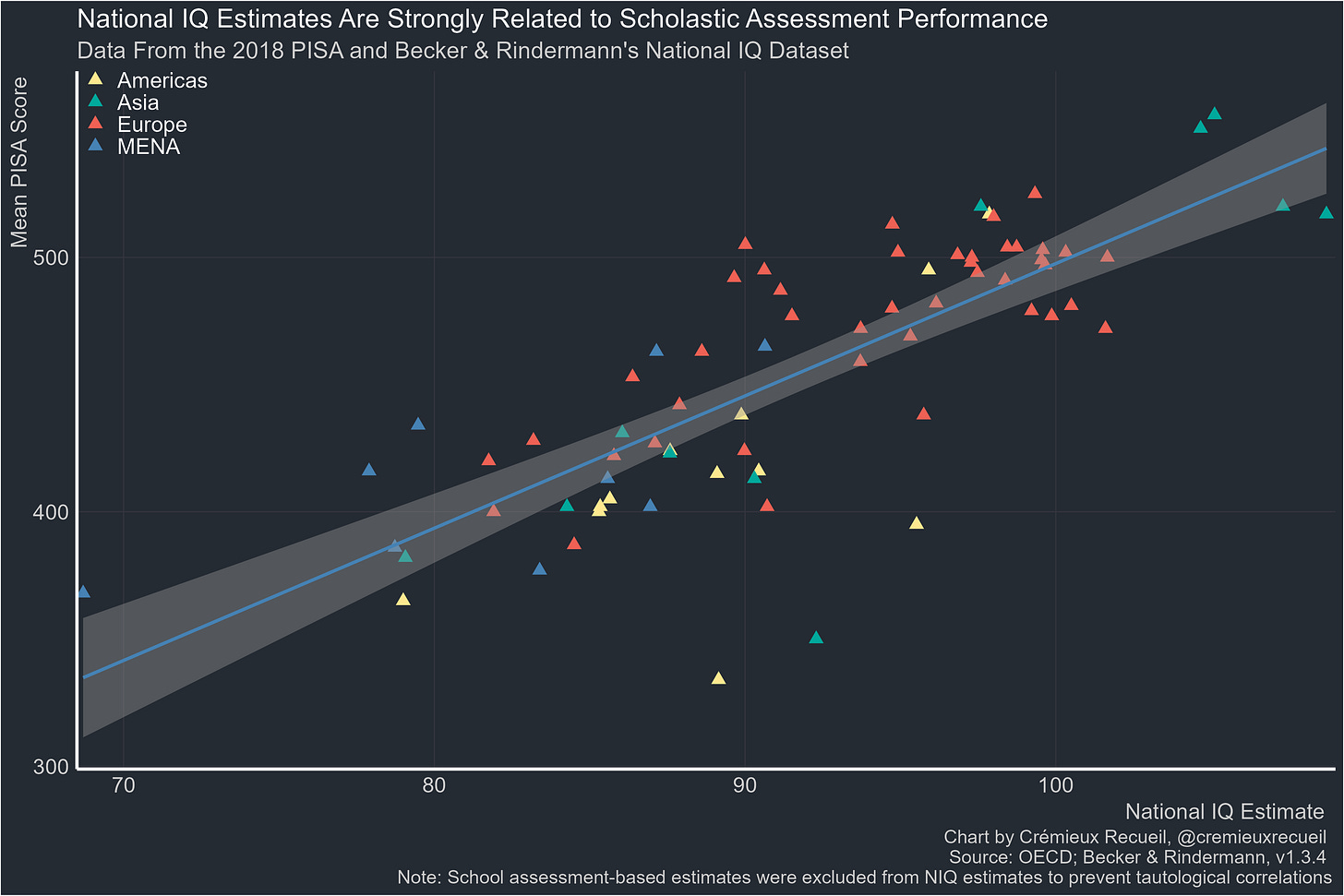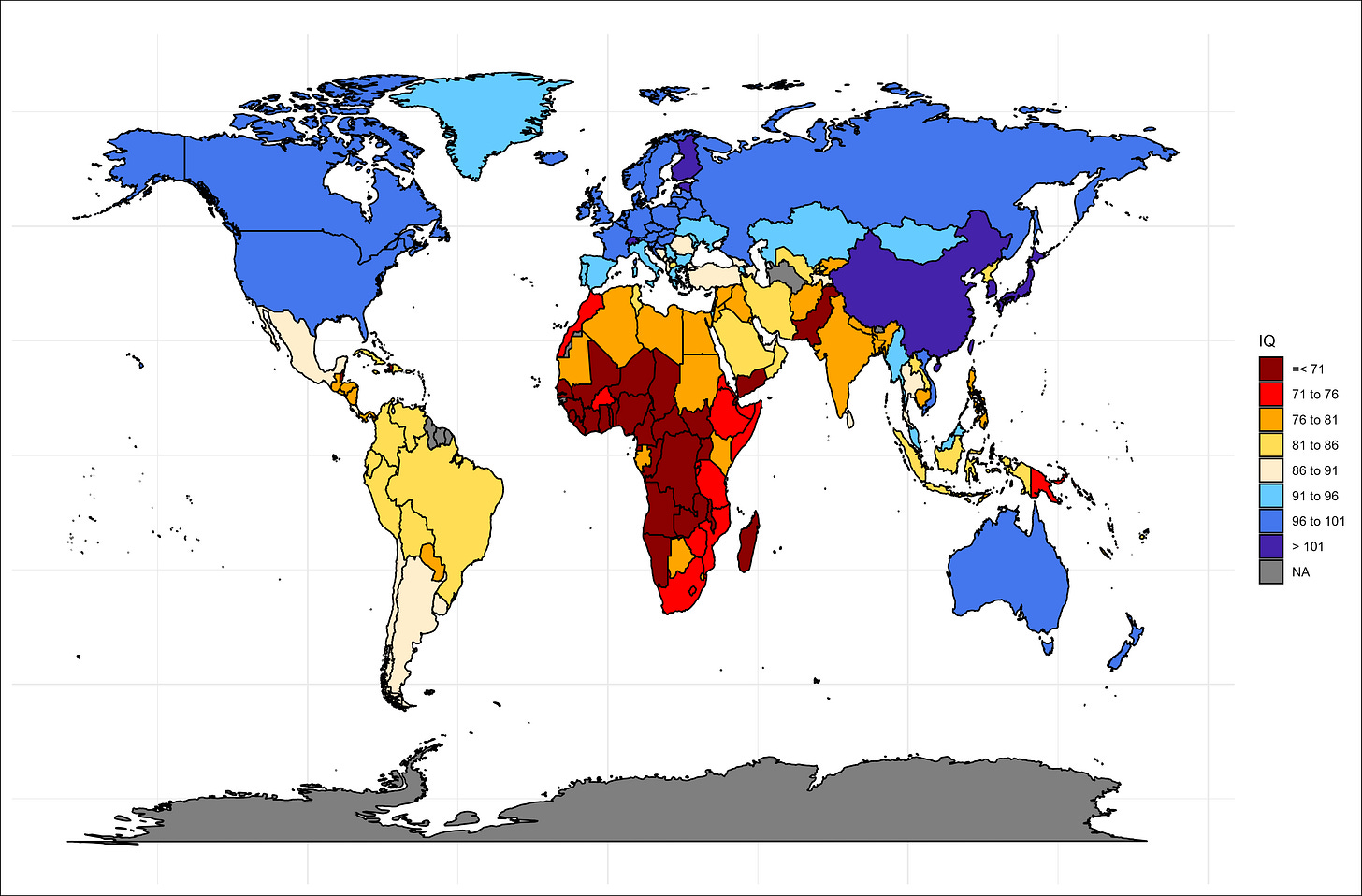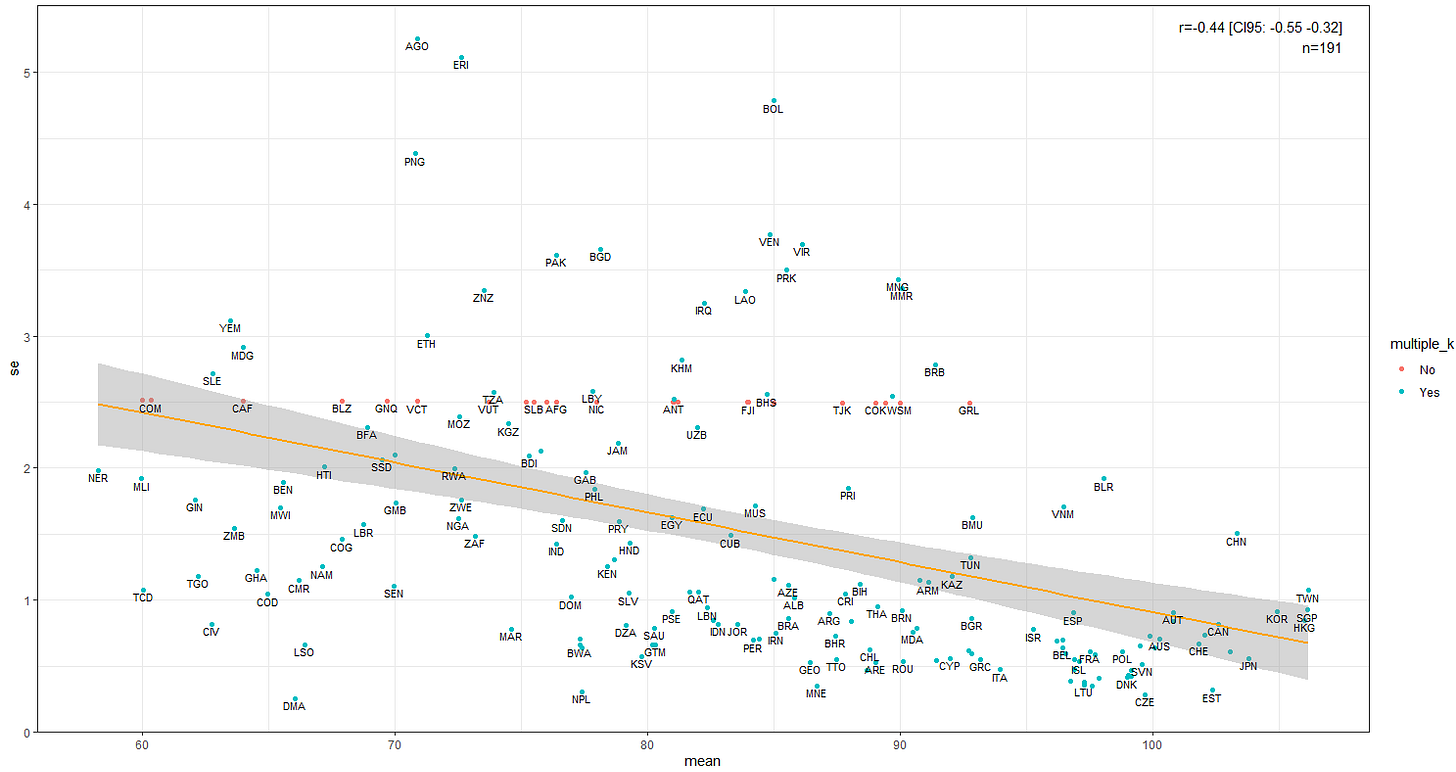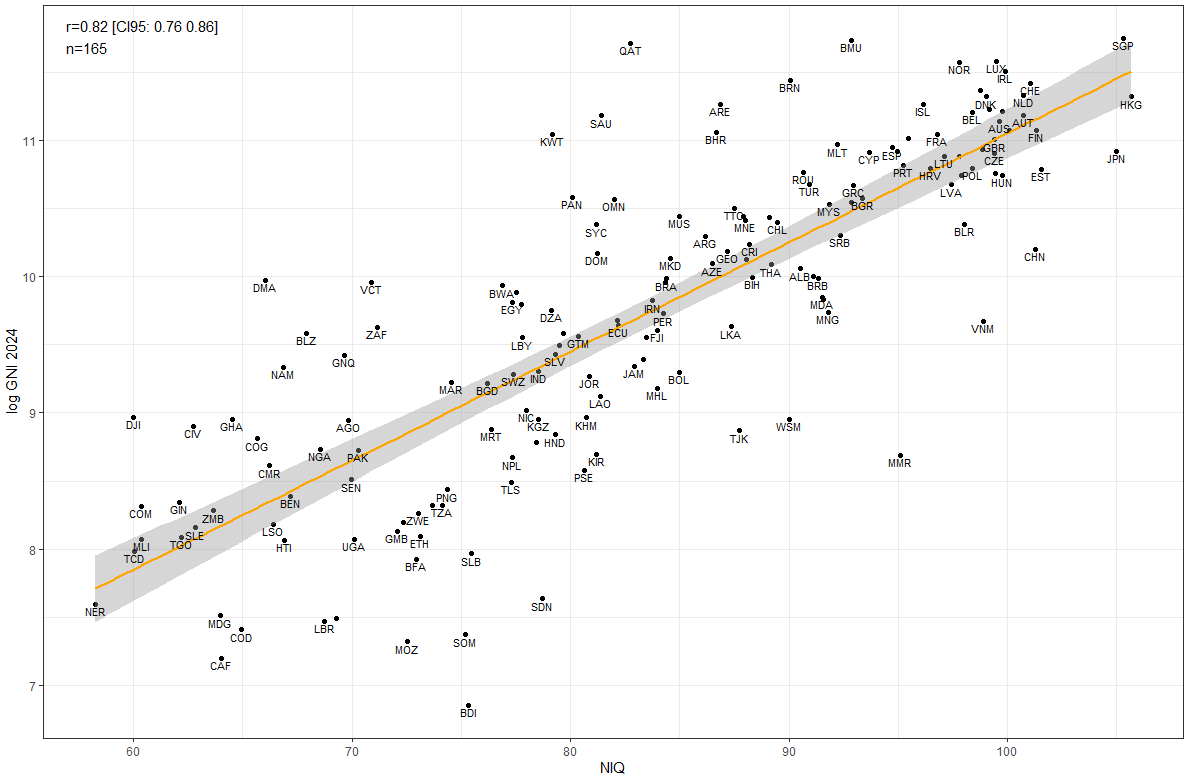Version 3
Methodology: a total of 5,645 means were compiled into the meta-analysis, most drawing from Becker’s dataset, PISA, PIRLS, TIMSS, the working memory meta-analysis, and the harmonised learning outcomes.
These means were classified into three categories: international scholastic tests, IQ samples (from Becker’s dataset + some other sources), and the samples from the working memory meta.
The IQ samples were adjusted for the effect of perceived selectivity (e.g. college students or white collar workers would be highly selected samples, janitors would be negatively selected) and location (urban, rural, national, etc). All samples were age-normed prior to the conduction of statistical analysis.
The memory samples were adjusted for the age of testing, year, perceived selectivity, and the type of test (e.g. forward span vs backward span). The standard deviations for these variables also had to be adjusted for these factors. IQs were then calculated using these means and standard deviations. The quality of these averages was nothing short of awful, despite my best efforts; according to the model, some of the samples had average IQs as high as 150 and as low as 40.
Then, all of the samples were combined into one file and subject to an anchoring process which controls all of the samples for bias at the category level. For example, if the PISA math test from 2008 gives scores 20 points higher in comparison to what would be expected from the set of tested countries, the scores were adjusted downwards by 20 points. The reference group (IQ = 100) is white Britons.
I then grouped the tests into six different categories: PIRLS, TIMSS, memory, PISA, IQ, and all other tests (other). I gave weights of 3 to the PIRLS, TIMSS, PISA, and ‘other’ averages, a weight of 2 to the IQ averages, and a weight of 1 to the memory averages. No manual revisions were made and I refused to impute the IQs of Turkmenistan, Guyana, Suriname, and French Guinea with proxies like performance in the IMO.
I also calculated the standard errors of these estimates by taking the standard deviation of the sample means and dividing it by the square root of the number of them1. Countries with only one sample had their standard errors estimated based on the observed relationship between number of samples and standard error:
On average, each country had a standard error of 1.53. This is a 41% improvement from the prior dataset (V2) which had an estimated average standard error of 2.58.
National IQ FAQ
Do IQ tests have a regional bias?
I reviewed the literature in this preprint and couldn’t come to a definitive conclusion. There is one study (Wicherts’, I believe) that found that GPA and IQ were less correlated in Africa than they were in Europe, but that could also be an artefact of worse grading. Most of the tools traditionally used to assess bias (differential item testing, comparing g-loadings across groups) find little evidence of bias, but I personally don’t think these methods work well.
When it comes to bias testing, the golden standard is taking variables that are assumed to be racially unbiased (e.g. education, income), regressing those onto IQ between groups, and observing if the slopes/intercepts differ to a practical/statistical extent. To my knowledge, there has been no attempt to do this across countries.
Speaking clearly, I think the largest issue with comparing cognitive tests across countries are education and effort. Education causes people’s IQ scores to increase because they become more familiar with standardised testing and improve their skills in maths/reading, but don’t actually get more intelligent. As such, more educated countries should have higher IQ scores that are not reflective of superior general intelligence. Some people have theories that IQ tests are biased by effort across countries, but I don’t see much evidence for this; empirical attempts to assess the question have found the opposite (check the appendix of said paper).
Alternatively, one could argue that there are factors that shrink the observed averages, like using between group standard deviations and imperfectly g-loaded tests. Overall, I would guess that the differences between countries are slightly inflated.
Is the average IQ in Sub-Saharan Africa really 70?
More or less. The score is reflective of their ability to take cognitive tests. An IQ of 70 is commonly used as a cutoff for intellectual disability in the United States, but I should note that this is not a hard cutoff and there is general agreement that IQ alone cannot be used to diagnose intellectual disability. I suspect that, controlling for education and measurement invariance, the true IQ of Sub-Saharan Africa is closer to 75.
Is the average IQ in China really 101?
The average is inflated by several points because Eastern provinces and urban areas are oversampled. A nationally representative sample of China would probably score somewhere between 95 and 100.
How much does biased collection play a role in the differences across countries?
Almost none. Lynn made some mistakes in the collection of the data but he was making an honest effort from what can be inferred.
About half of the data come from international scholastic assessments that take (roughly) representative samples of students and compare them in terms of their ability. Despite the samples being massive and the data collection being conducted by an independent body, the scores on these tests correlate reasonably well with the ones found in IQ tests:

Are any of these values based on geographical imputations?
No.
Do you have any concerns with the estimates of specific countries?
I think that China probably has an IQ in the upper 90s, Mynamar in the mid 80s, Kazakhstan in the upper 80s, and North Korea in the low 90s.
I think the North Korean IQ is deflated by sampling refugees who live in South Korea and I think the Chinese IQ is inflated because Eastern provinces higher in intelligence are disproportionately sampled. I don’t have any specific comments on the others but they seem to be at odds with their levels of development and cultural prominence.
V3 Appendix:
Average IQ by region:
region mean_IQ
<chr> <dbl>
1 Eastern Asia 99.823
2 Western Europe 99.794
3 Northern Europe 98.801
4 Australia and New Zealand 98.721
5 Northern America 96.111
6 Eastern Europe 96.004
7 Southern Europe 91.588
8 South-eastern Asia 88.311
9 Polynesia 86.841
10 Central Asia 85.608
11 Western Asia 83.863
12 Micronesia 82.047
13 Latin America and the Caribbean 82.007
14 Southern Asia 78.556
15 Melanesia 78.513
16 Northern Africa 78.503
17 Sub-Saharan Africa 69.308Values:
alpha3 NIQ se
<chr> <dbl> <dbl>
1 HKG 105.689 0.846
2 SGP 105.317 0.923
3 JPN 104.964 0.556
4 TWN 104.87 1.073
5 KOR 103.27 0.915
6 LIE 102.05 0.734
7 EST 101.553 0.315
8 FIN 101.335 0.838
9 CHN 101.286 1.503
10 MAC 101.206 0.61
11 CHE 101.055 0.669
12 AUT 100.735 0.905
13 NLD 100.724 0.654
14 CAN 100.106 0.817
15 IRL 99.923 0.637
16 HUN 99.791 0.422
17 SWE 99.778 0.348
18 AUS 99.619 0.703
19 LUX 99.479 0.594
20 RUS 99.432 0.431
21 GBR 99.406 0.584
22 CZE 99.396 0.283
23 DEU 99.152 0.724
24 DNK 99.025 0.414
25 VNM 98.904 1.706
26 SVN 98.841 0.513
27 USA 98.77 0.465
28 POL 98.398 0.611
29 BEL 98.38 0.641
30 BLR 98.035 1.918
31 SVK 97.884 0.381
32 NZL 97.823 0.546
33 NOR 97.804 0.472
34 LVA 97.423 0.407
35 SCO 97.308 0.384
36 LTU 97.123 0.358
37 FRA 96.774 0.609
38 HRV 96.464 0.696
39 ISL 96.14 0.531
40 ITA 95.478 0.471
41 PRT 95.223 0.691
42 MMR 95.079 3.362
43 ISR 94.981 0.776
44 ESP 94.733 0.902
45 CYP 93.698 0.559
46 BGR 93.345 0.864
47 GRC 92.931 0.551
48 KAZ 92.868 1.177
49 BMU 92.844 1.624
50 GRL 92.725 2.491
51 SRB 92.354 1.147
52 MLT 92.233 0.595
53 MYS 91.854 0.788
54 MNG 91.801 3.429
55 UKR 91.572 0.613
56 MDA 91.524 0.76
57 BRB 91.365 2.785
58 ARM 91.097 1.132
59 TUR 90.913 0.544
60 ROU 90.664 0.534
61 ALB 90.51 1.015
62 BRN 90.06 0.92
63 WSM 90 2.493
64 CHL 89.46 0.625
65 TCA 89.4 2.494
66 THA 89.181 0.949
67 URY 89.088 0.464
68 COK 89 2.494
69 BIH 88.339 1.122
70 CRI 88.19 1.048
71 MEX 88.046 0.839
72 MNE 88 0.351
73 PRI 87.93 1.849
74 TJK 87.71 2.495
75 TTO 87.523 0.547
76 LKA 87.375 2.541
77 GEO 87.199 0.526
78 ARE 86.866 0.526
79 BHR 86.7 0.727
80 AZE 86.512 1.111
81 ARG 86.172 0.897
82 VIR 86.1 3.695
83 VEN 85.802 3.771
84 PRK 85.5 3.5
85 NCL 85 2.496
86 MUS 84.978 1.716
87 BOL 84.97 4.784
88 BHS 84.733 2.557
89 MKD 84.587 0.705
90 BRA 84.389 0.864
91 COL 84.365 1.157
92 PER 84.265 0.694
93 FJI 84 2.497
94 MHL 83.96 2.497
95 IRN 83.751 0.752
96 TUN 83.486 1.322
97 UZB 83.321 2.307
98 JAM 82.915 2.188
99 QAT 82.755 1.064
100 CUB 82.507 1.489
101 ECU 82.209 1.688
102 IDN 82.162 0.816
103 OMN 82.026 0.845
104 LBN 81.966 0.94
105 TON 81.522 2.52
106 SAU 81.421 0.787
107 LAO 81.35 3.336
108 DOM 81.23 1.02
109 SYC 81.198 1.061
110 KIR 81.18 2.499
111 ANT 81.035 2.499
112 MNP 81 2.499
113 KSV 80.954 0.573
114 JOR 80.884 0.815
115 KHM 80.729 2.817
116 PSE 80.63 0.912
117 GTM 80.366 0.663
118 PAN 80.087 0.66
119 IRQ 79.664 3.252
120 PHL 79.475 1.841
121 SLV 79.326 1.051
122 HND 79.29 1.433
123 KWT 79.162 1.305
124 DZA 79.134 0.811
125 SDN 78.713 1.604
126 KGZ 78.535 2.334
127 IND 78.533 1.428
128 KEN 78.456 1.253
129 SYR 78.222 2.132
130 NIC 77.966 2.501
131 LBY 77.812 2.58
132 PRY 77.764 1.595
133 GAB 77.537 1.97
134 SWZ 77.407 0.635
135 NPL 77.332 0.303
136 EGY 77.331 1.627
137 TLS 77.304 0.702
138 BWA 76.902 0.657
139 AFG 76.4 2.502
140 MRT 76.4 2.502
141 BGD 76.188 3.66
142 CYM 76 2.502
143 SLB 75.486 2.502
144 BDI 75.312 2.094
145 SOM 75.202 2.503
146 MAR 74.541 0.781
147 PNG 74.381 4.383
148 TZA 74.15 2.578
149 VUT 73.695 2.504
150 ZNZ 73.537 3.345
151 ETH 73.141 3.002
152 ZWE 73.024 1.761
153 BFA 72.936 2.31
154 ERI 72.619 5.112
155 MOZ 72.547 2.391
156 RWA 72.367 1.998
157 GMB 72.063 1.734
158 ZAF 71.156 1.485
159 VCT 70.88 2.505
160 PAK 70.311 3.617
161 UGA 70.099 2.101
162 SEN 69.972 1.108
163 AGO 69.817 5.257
164 GNQ 69.667 2.506
165 MWI 69.269 1.7
166 SSD 68.818 2.062
167 LBR 68.757 1.57
168 NGA 68.535 1.617
169 BLZ 67.914 2.507
170 BEN 67.181 1.894
171 HTI 66.902 2.008
172 NAM 66.873 1.252
173 LSO 66.423 0.662
174 CMR 66.199 1.147
175 DMA 66.04 0.25
176 COG 65.653 1.459
177 COD 64.951 1.042
178 YEM 64.839 3.115
179 GHA 64.516 1.224
180 CAF 64 2.51
181 MDG 63.983 2.912
182 ZMB 63.654 1.541
183 SLE 62.818 2.718
184 CIV 62.755 0.815
185 TGO 62.21 1.179
186 GIN 62.094 1.757
187 COM 60.355 2.512
188 MLI 60.348 1.919
189 TCD 60.046 1.076
190 DJI 60 2.512
191 NER 58.249 1.981Correlation matrix:
Sample mean and estimated standard error:
Correlation between GDP per capita (IMF data, PPP controlled) and IQ:
World IQ: 85.8
Link to dataset (it’s the last file).
Version 2
White British mean/SD set to 500/100.
Methodology: composite of various datasets. Paper will be out in a few months.
Preprint is now out!
World IQ: 85.6 weighted by population
Technically this estimates the standard error of the mean of all samples (not weighted subcategories), though I thought that this standard error would be a better estimate of the error in the estimates than the one that would be calculated from the subcategories.










Better is to predict many external outcomes and average across them to find the best set of estimates. This is best on the assumption that maximizing reliability and construct validity will maximizing predictive validity. I suggest you download the SPI and use the indicators as your outcomes. Average across them (remember to use absolute values, or reverse by the S factor loading), and see which set does the best. https://www.socialprogress.org/
National IQ have been my main obsession for the last few days. Spending countless of hours. Figuring out the correct numbers etc.
Thank you for this beautiful post seb. This feels like Christmas